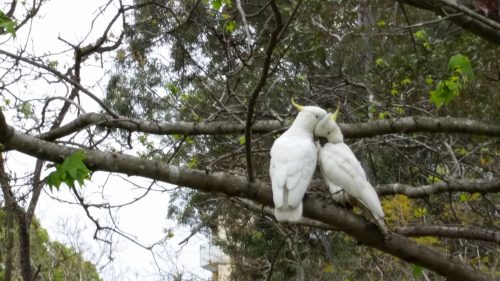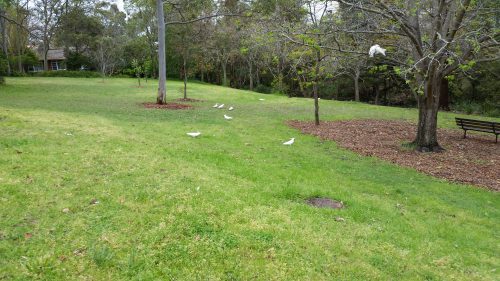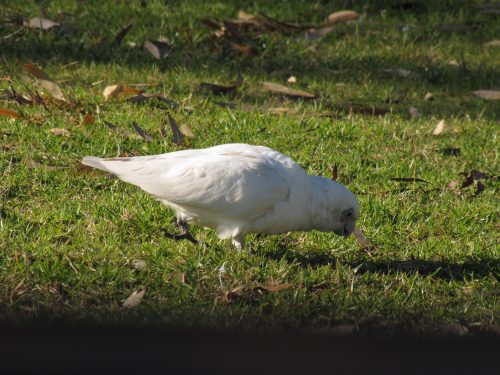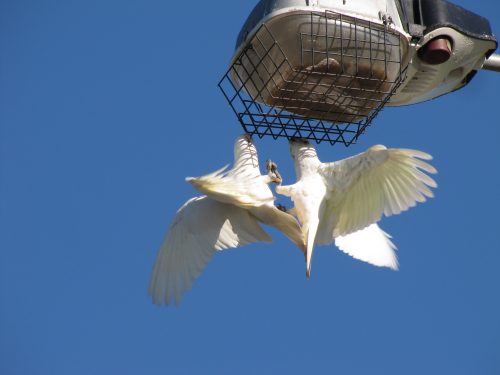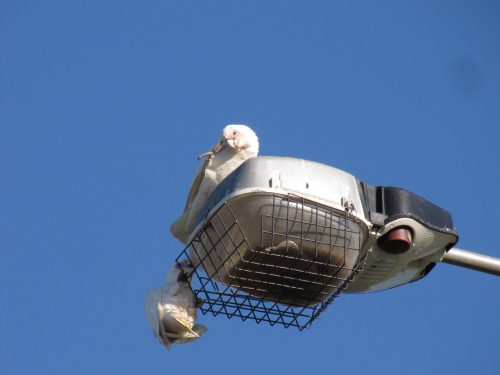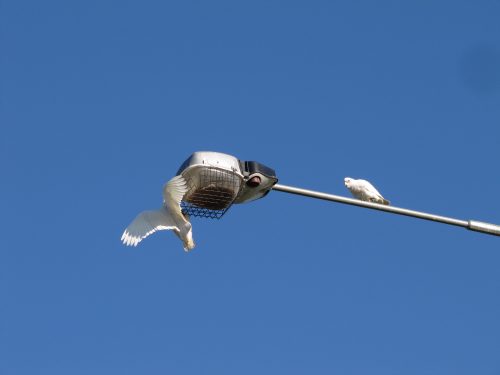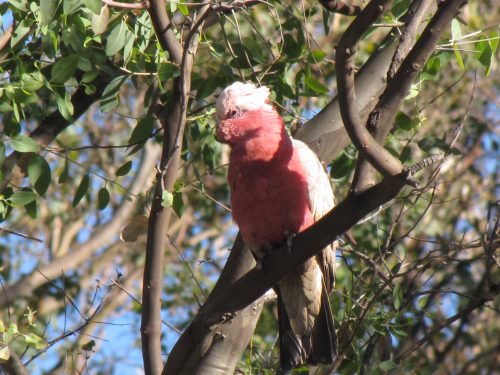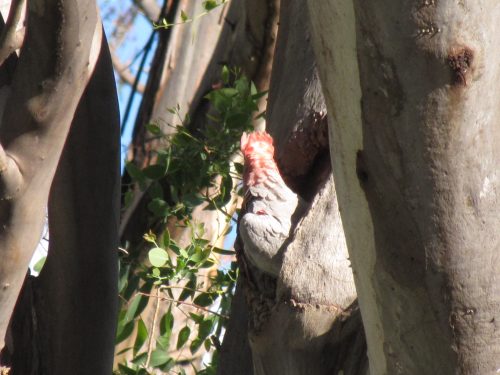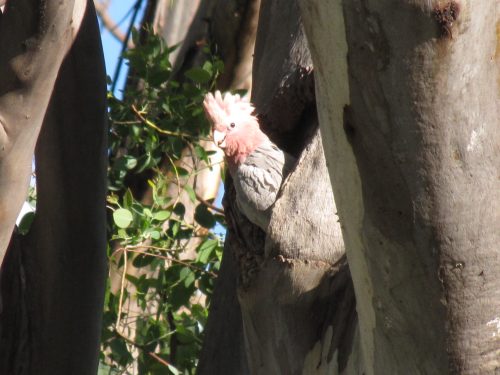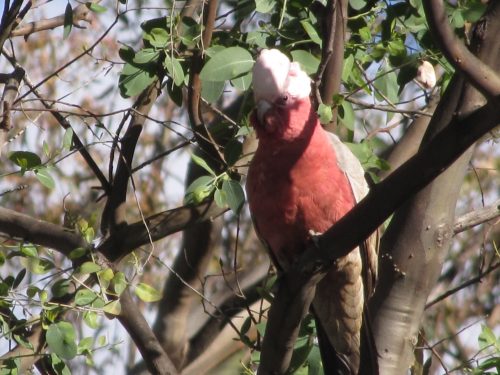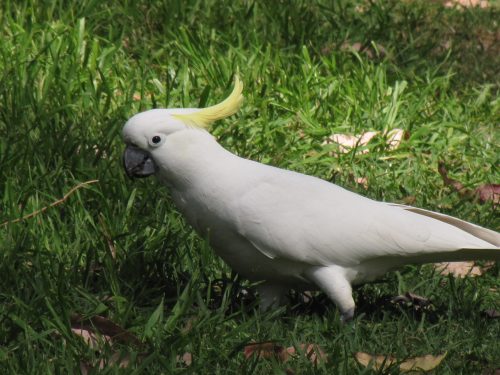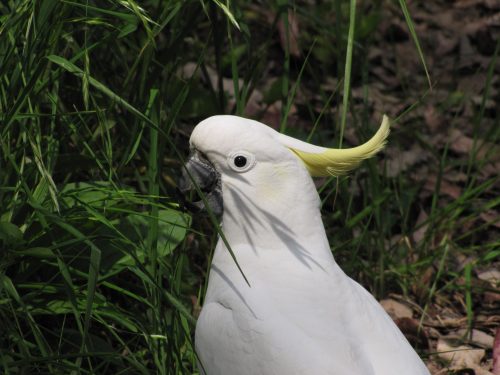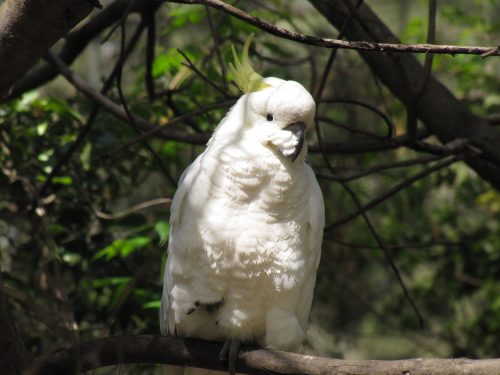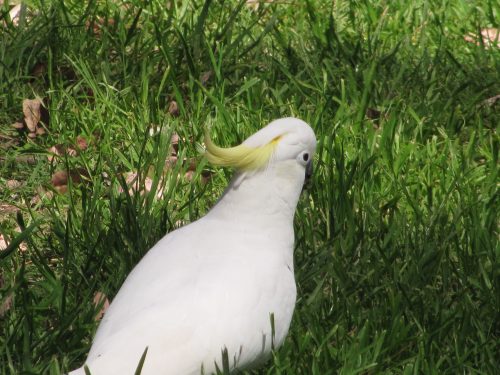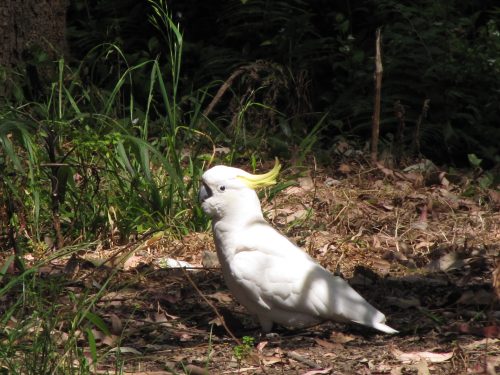A busy pair of Galahs
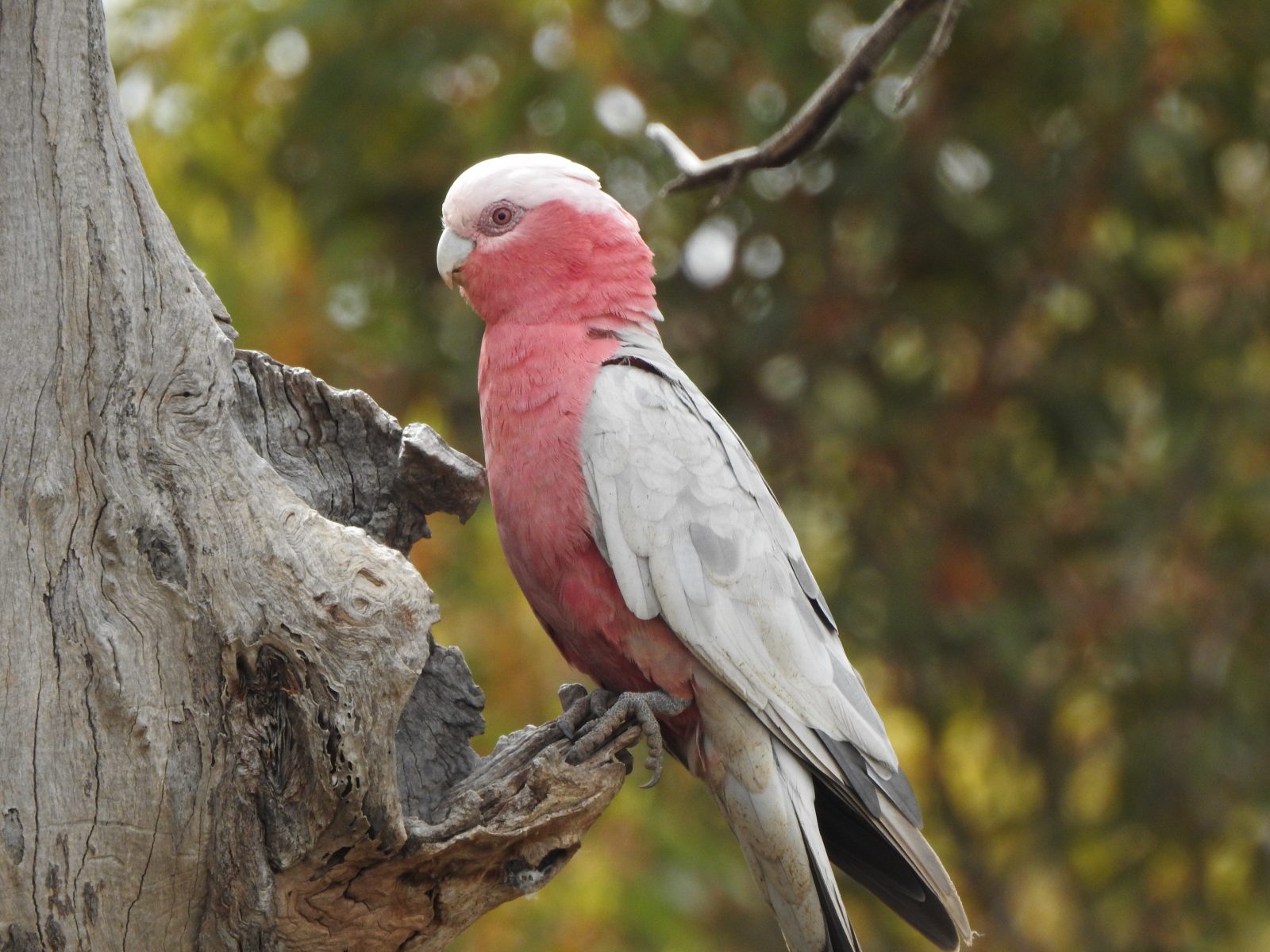
Resident nesting Galahs
I live on the edge of the rural city of Murray Bridge which is about an hour’s drive from Adelaide, South Australia. We are blessed to have a variety of parrots, cockatoos and lorikeets in the region. One of the common birds in this family is the Galah. I am sure that if I took a census of this species over a whole year, there would be very few days pass without seeing at least a handful of these lovely parrots either resting in the trees in my garden, or flying overhead. On occasions, I have even seen flocks of many dozens through to many hundreds. They are a very common species in this area.
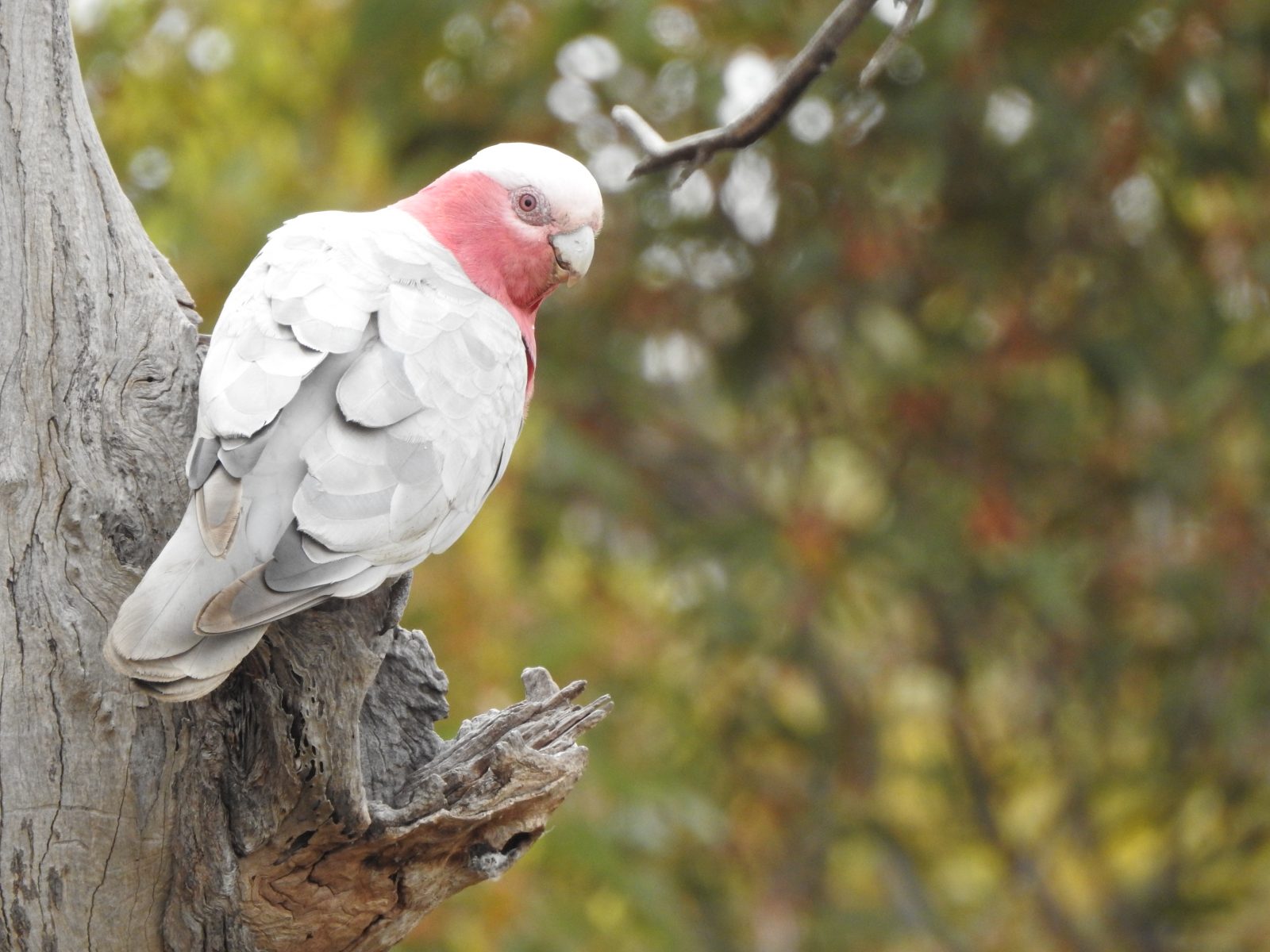
Easy birding
The photos shown in today’s post were all taken in my garden and all within a few minutes of each other. This hollow is in an old-growth mallee tree within about twenty metres of my back veranda. I have a comfortable chair located there and I enjoy sitting there reading – or just watching the birds all around. It is very relaxing and quite lovely that the local, resident birds just go about their activities while totally ignoring me. It also makes photography easy.
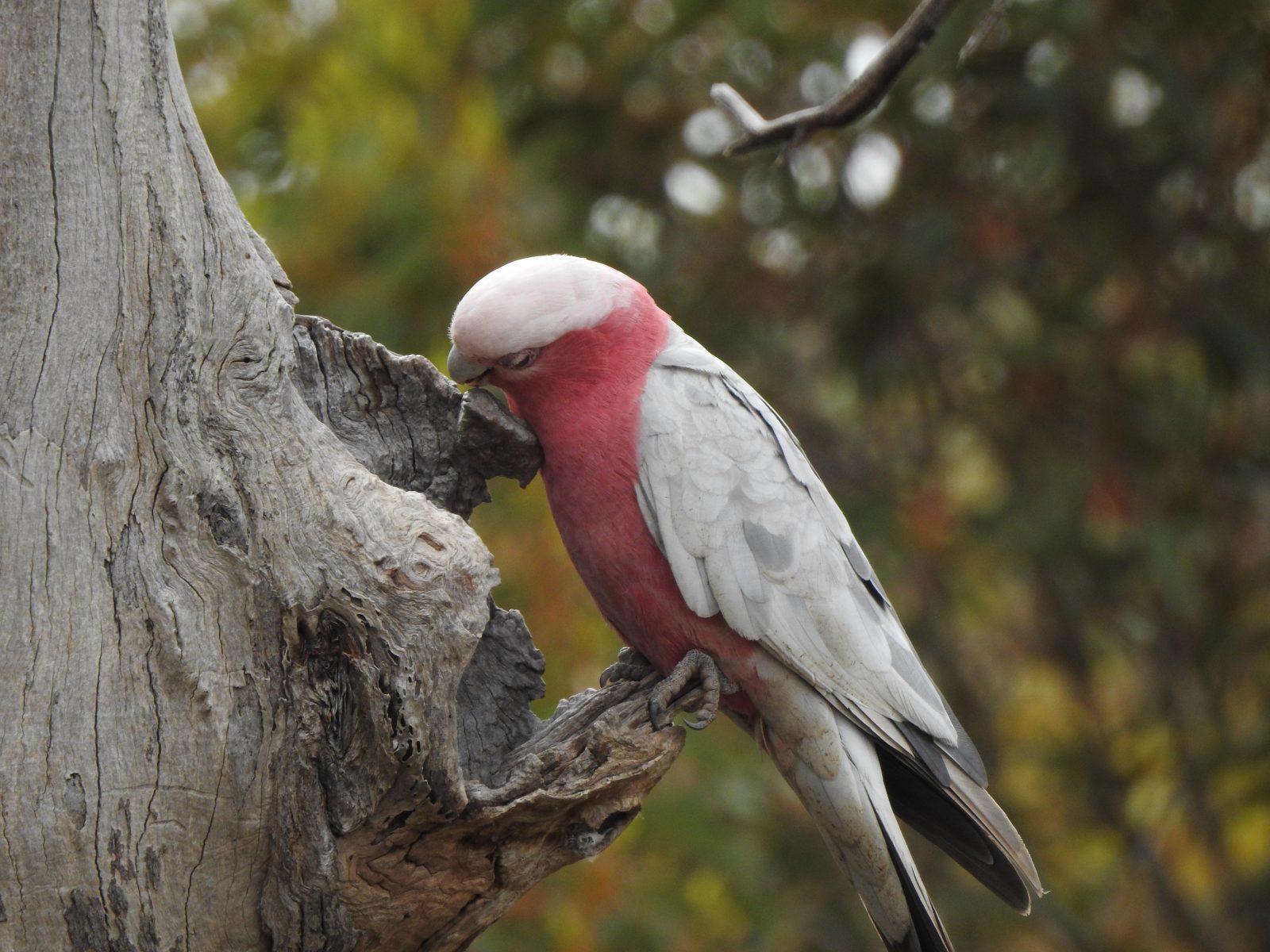
Nesting attempts
A pair of Galahs have been working at this hollow for some years. Then, about four years ago they started putting fresh eucalypt leaves in the hollow. I eagerly anticipated a nesting attempt but they abandoned their quest. About once or twice a day they would sit at the opening of the hollow and screech loudly into the hollow – then fly away.
Strange, I thought.
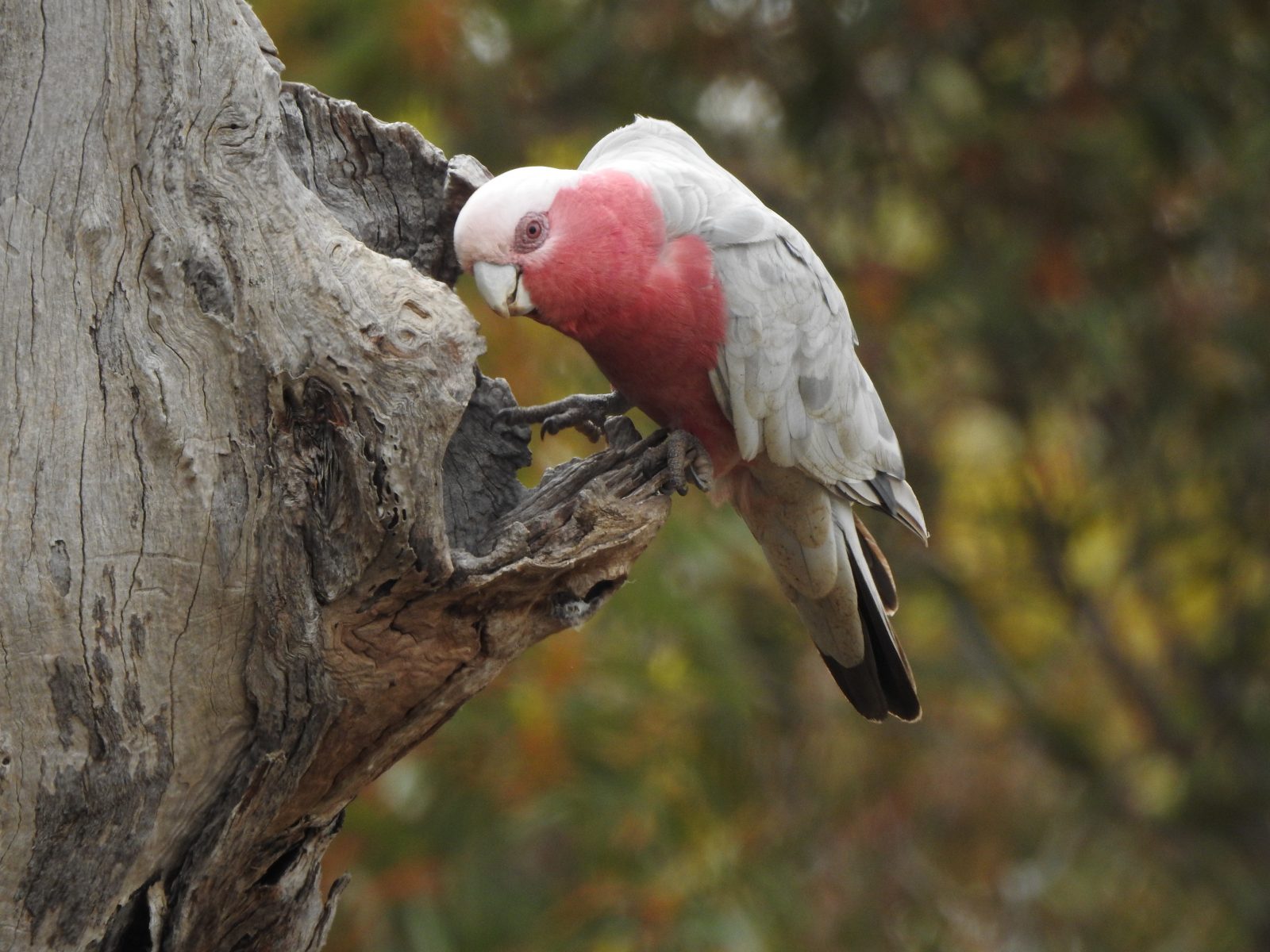
An interloper takes over
A few days later I discovered the reason why they hadn’t successfully nested in the hollow. I saw a Brush-tailed Possum coming out of the hollow. It had evicted the Galahs from their home. After some months I guess that the possum had moved on elsewhere. In fact, I haven’t seen one or heard one on the roof for several years now. So the Galahs returned to their home.
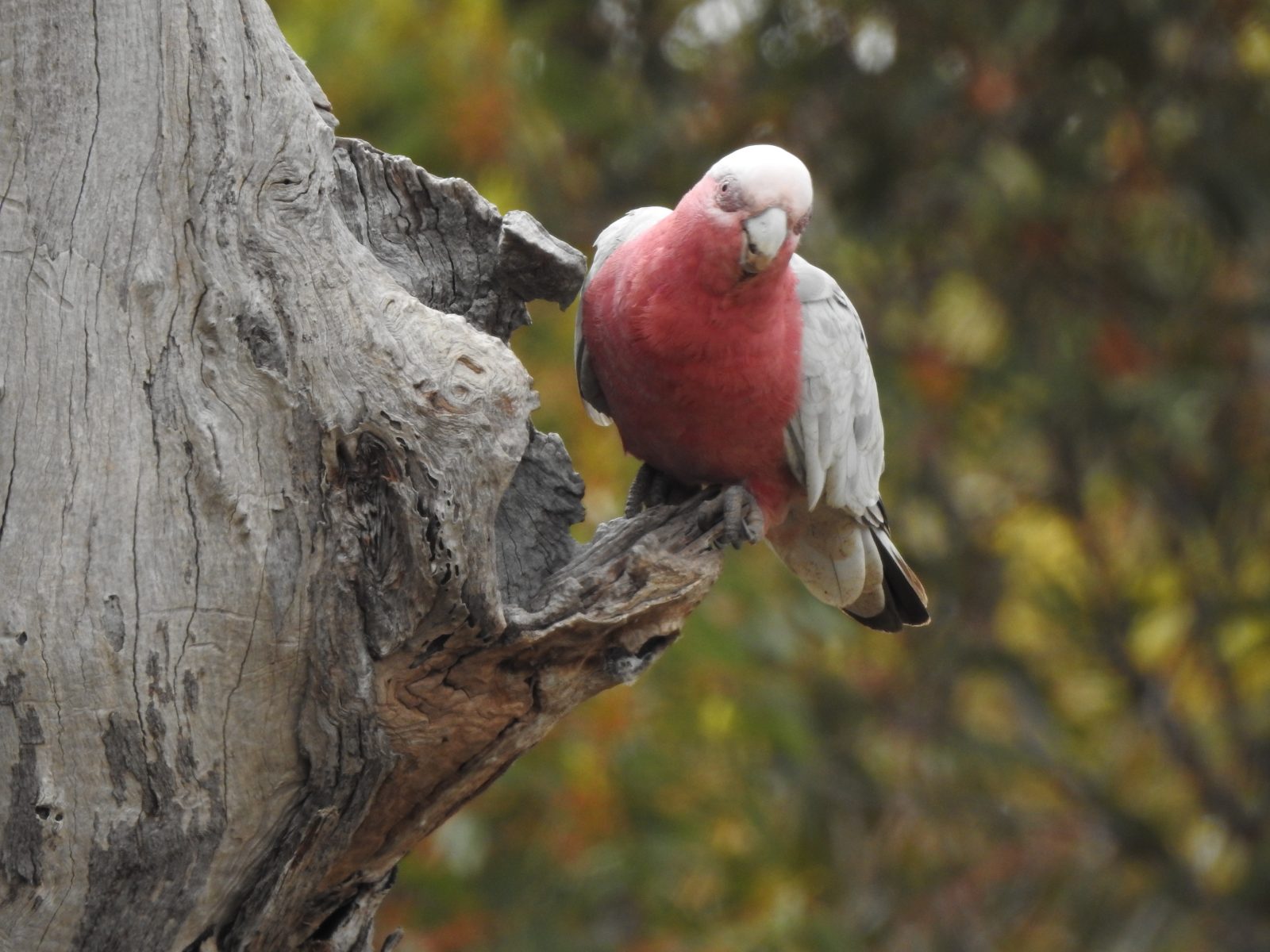
Success at last
During late winter last year they again started working on the hollow. During the next month or so they successfully laid eggs and raised their chicks which later fledged. This year they have again been successful. I didn’t manage to get a photo of this year’s chicks because they flew off before I could get a shot. Instead, I have included below a photo of one of the chicks from last year’s brood.
A few days after the two chicks fledged, they were precariously hanging on to the branches of the trees nearby, along with about a dozen other chicks from other parents. Most of them were calling to be fed, and as the parents came in to feed them I had a very noisy Galah nursery in my garden.
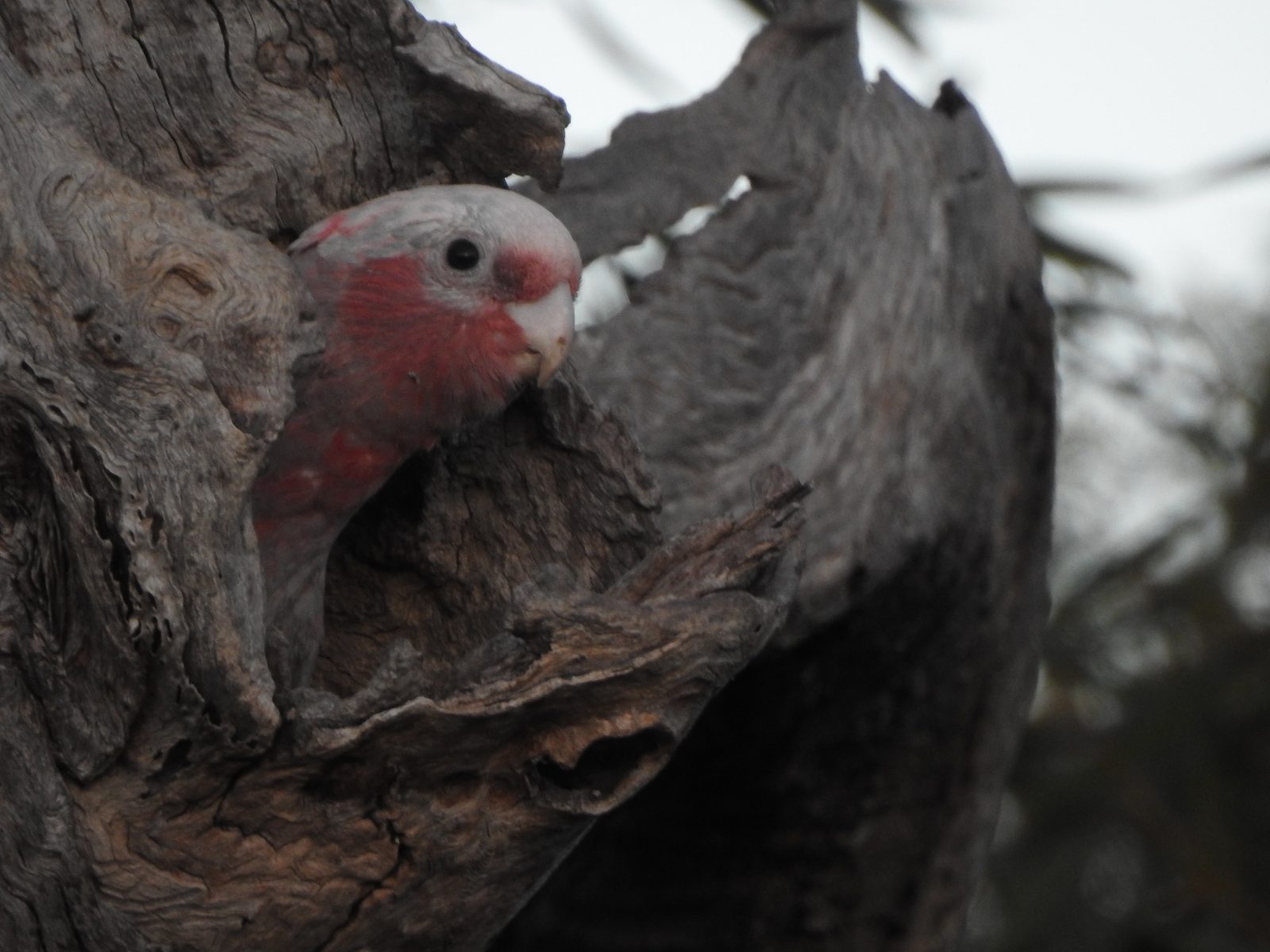
Sulphur-crested Cockatoos preening
Last month on a visit to Sydney, I timed my arrival to coincide with my grandson’s 10th birthday party. I arrived about ten minutes before the guests started descending on the small park near Chatswood, a suburb of Sydney near where my son and his family live. It had been threatening to rain all morning, and the preceding few days had been quite wet. The children present at the party were all keen to get out and play. No amount of rain would deter them as we found out later.
While some games on the grass were underway, my attention was diverted from the children and their enthusiastic pursuits. A small flock of Sulphur-crested Cockatoos had flown in to a nearby part of the park. I slowly moved closer to get some photos of them on my phone. I just did not feel like walking all the way to the car to get my camera. The flock can be seen in the photo below, but I was more interested in the two birds in the photo above. They ignored me getting closer and closer. They appear to be whispering to each other in a quite romantic way. (Forgive me; it is the “story-teller” in me writing this.)
In reality, they are just preening each other’s feathers, something most parrots do regularly. In fact, all birds indulge in preening on a regular basis. Preening helps to keep the feathers clean and tidy, which in turn assists in flight and their general health and well-being. So, while I may have thought that this pair was being all loving to one another, what they are doing is actually very practical help.
Good birding,
Trevor
Corellas: Villains of the Bird World
Birding time out
From time to time I take out a few minutes from my day to go birding. Sometimes these few minutes stretch into a few hours. I recently took off a whole afternoon. During this time, I visited six birding spots around my home town of Murray Bridge which is about an hour’s drive south-east from Adelaide.
Sturt Reserve
One of the spots I visited was Sturt Reserve. This lovely spot is on the banks of the Murray River. It is named after Captain Charles Sturt who explored the river in 1830. The reserve has large areas of lawn for picnics, a large playground and a restaurant. It also plays host to a wide variety of birds.
Little Corellas
On my recent visit, there were quite a few Little Corellas in the trees along the river. In flocks of 30 – 50 they can be annoyingly noisy. In recent years, these flocks have grown into the hundreds on many occasions. They are known to be high on the list of the Villains of the Bird World.
Havoc
In large flocks like one can see at Sturt Reserve – and other spots around the district – they can wreak havoc on trees, stripping leaves, twigs and bark from trees until little is left but for a carpet of gum leaves on the ground below. The nearby lawn-tennis courts have also been a target of these destructive birds. They have sometimes left the courts unusable after the sharp beaks of several hundred birds have visited. Various methods to disperse the flocks have been tried, but without much success. This is a widespread problem in many places in South Australia.
Large flock
Later, I drove a few kilometres to the southern edge of town to visit Swanport Reserve, also on the banks of the river. Here I witnessed flocks of several hundred corellas flying along the river and then out onto recently cultivated farmland across the river. Because of the distance, I was only able to estimate their numbers. After many smaller flocks had joined into one large flock, there must have been at least 1200 birds – possibly as many as 2000.
The photos below were taken at Sturt Reserve. They show the playfulness of some of the birds on the street lights. While I couldn’t see any damage to the lights from their beaks, they are quite capable of causing the local council some expensive headaches.
Further reading:
What are these Galahs up to?
On our return trip from Sydney last year, we didn’t take the direct route home to Murray Bridge. Instead of taking two days to get home, we took a circuitous route through north-western New South Wales. We drove through Lithgow, Capertee Valley, Mudgee, Dunedoo, Cobar and Broken Hill. We saw some parts of the country we had never visited before, which is always an interesting way to travel.
On our first night away from Sydney, we stopped at one of the caravan parks in the town of Mudgee. We arrived late in the afternoon. After we had unpacked and settled into the cabin, we sat on the front deck of the cabin enjoying the balmy evening and a nice cuppa. As we were sitting there I had my notebook and binoculars at the ready, as well as my camera. My attention was soon drawn to a Galah perched in a nearby tree. This tree was about 30 metres from where we sat.
I noticed that the Galah was not attempting to fly away, but it was interested in what was happening further down the trunk. Another Galah, presumably its female mate, had emerged from a hollow there (see photos below). It looked as if the female was preparing the hollow ready for nesting. This was last Septemeber, right about the time they begin preparing nesting hollows for their next brood. I have no evidence that this pair went ahead and had a brood of young because we moved on elsewhere next morning.
The Galah is one of Australia’s most recognisable parrots. We have many colourful parrots in Australia – you can see photos of some of them by doing a search on this site. I have written frequently about parrots over the years and have included many photos of them. Some of these posts are included in “Further Reading” below.
Further Reading:
Sulphur-crested Cockatoos in Lane Cove
One of Australia’s most recognised and common birds would have to be the Sulphur-crested Cockatoo. I have included a series of photos of this species in this post today. It is found along the north, east and southern coasts of Australia, and in Tasmania. It has been introduced to the south of Western Australia, and in New Zealand.
Large flocks
Throughout its range, it can often be found in large flocks numbering from a few dozen through to many hundreds. In my travels around different parts of Australia, I have observed this species in large numbers, especially where there is an abundance of seed for them to feed on, such as pastures. I have seen large flocks settle in paddocks, making the ground look like snow has fallen. When a flock is feeding on the ground, one or more birds will perch in a tree or on a fence post watching out for any danger. A large flock can also add colour to a dull grey looking gum tree when they all perch together.
Noisy birds
These birds have a very raucous call, and when a flock flies low overhead while calling, it is very hard to carry on a conversation. In some caravan parks we have stayed in where this bird is resident, a noisy flock can be an unwelcome alarm clock, particularly at first light when one wants to sleep in a little. In populated areas, this beautiful bird is often regarded as an unwelcome pest. With such an abundance of food, cockatoos can easily get bored and start chewing on timber work around houses and other buildings. Some of my readers have complained in the past about the destructive nature of this species. There is no easy solution to this problem because this species is a protected bird, like all of our native birds. If you are having a problem with cockatoos, please be in contact with your local National Parks and Wildlife office. It is an offence to destroy them.
Good pets
This species is also a common, long-lived pet for many people. They can be delightful pets and will often learn a range of words and phrases to mimic their owners. I am not familiar with the current regulations on keeping our native birds as pets, so it is best to talk to your local pet shop owners before buying a cockatoo as a pet. They are probably commonly available in pet shops in countries other than Australia. There should be no restrictions on keeping them outside of Australia.
The photos in today’s post were all taken of an individual in the Lane Cove National Park in Sydney. we were staying with our son spending time with our grandchildren during school holidays. On this occasion, we had a few hours break from the children, so we packed a picnic lunch and drove the short distance to the national park. Along the Lane Cove River, there are many lovely grassed picnic areas, complete with picnic tables and gas barbeques for the public to use.
Corellas v Cockatoos
Some people can easily be confused when trying to identify cockatoos and corellas. The three species of corellas in Australia are the Little Corella, Long-billed Corella and the Western Corella. Their ranges often overlap. I have even seen mixed flocks consisting of two species. Corellas are generally a little smaller and all corellas lack the yellow crest of the Sulphur-crested Cockatoos. The calls are also different, with the corellas’ calls being not as loud or as harsh.
Further reading:
- Sulphur-crested Cockatoos up close
- Red-tailed Black-cockatoos
- Gang-gang Cockatoos
- Great Birding Moments #13
- Trevor’s Photos – buy some of my photos on a variety of products such as mugs, place mats, t-shirts and many more.
- Little Corellas at Mannum
- Long-billed Corellas
